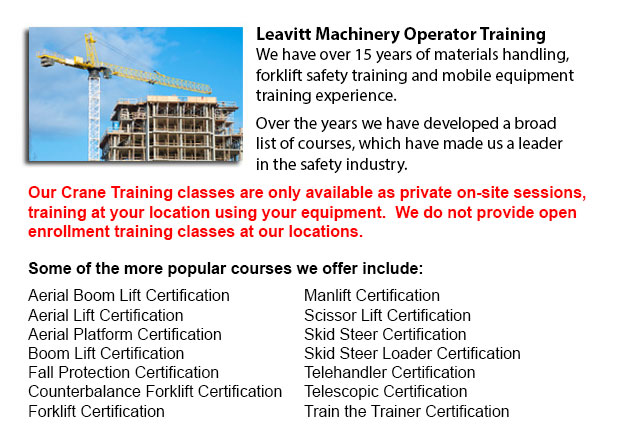
Langley Crane Certification - The Crane Certification Program includes the industry recommended content that will teach the safe and efficient operation of cranes. The person would train in the following: how to identify cranes and their component parts; pre-operational, operational and post-operating requirements; rigging components and inspection/rejection criteria; how to determine overall lift capacity; and needs specific to the work site where the individuals training would be working.
Pre-operational requirements comprise assigning authority for the pre-operational check; doing the sequential pre-operational check based on the manufacturer's specifications or specifications certified by a professional engineer; checking the work place for obstacles and hazards; checking the log book for comments; checking cables, hooks, chains crane movement and safety latches; ensuring the right functioning of operational controls; and knowing how to make sure that the disconnect switch/isolator of the crane is functioning right.
Operational requirements comprise identifying roles and responsibilities, and determining the requirement for a formal lift plan. Individuals training would know how to perform a hazard assessment related to environmental circumstances, physical situations and staff. Subject matter consists of determining when to seek competent support, the safest route and destination of loads, and load weight and centre of gravity.
It is vital for individuals training to be able to identify an over-capacity lift, choose correct rigging equipment, be aware of load limits, and determine a safe place from which to operate. Individuals training would review both site-specific and universal crane signals for lifts, and techniques for lifting, loading and traveling. Proper maintenance practice would be included.
The trainee would undergo an examination to test their understanding of emergency response procedures for different conditions, specifically mechanical or electrical failures. They would be asked to describe parking and shut down procedures for safety and security, to follow lock out and tagging techniques, and to explain the reason why near misses are reported and recorded to the appropriate individual. Log book records need to be maintained.
Individuals training will develop knowledge of rigging, particularly, establishing who has authority and responsibility for rigging, identifying different kinds of rigging, knowing storage procedures and load capacity ratings.
Post-operational requirements include entering deficiencies or defects, maintenance and service history within the log book, according to Federal, state and provincial codes requirements.
Furthermore, we include site-specific needs to meet the employers requirements into our crane certification training program.
-
Operator Safety Certification | Re-Qualification Certification | In-House Instructor Certification in Langley
Lift trucks are utilized in nearly all warehouse operations and in boat yards and in industrial construction sites. The reach feature of a forklift is a vital component used in several applications like for example whenever a shelving system is being... More -
Skid Steer Loader Certification in Langley
The engine powered skid-steer loader consists of a small and rigid frame, equipped along with lift arms that could connect to numerous industrial attachments and tools to carry out several labor saving jobs. Normally, skid-steer loaders are four-whee... More -
Langley Forklift Training Classes
Langley Forklift Training Classes - Forklift are heavy pieces of industrial machines that are utilized in transporting and the handling of merchandise and materials. They are often known as Lift trucks and are found in all kinds of industries. Employ... More -
Langley Heavy Equipment Operator Certification
Langley Heavy Equipment Operator Certification - The heavy equipment operator is an individual who manipulates the controls and drives various kinds of big machinery. Heavy machines is most commonly used on construction sites in order to deliver supp... More -
Langley Crane License
Langley Crane License - Crane operators ought to be "credentialed", which means they ought to own a crane operator license or certification. Credentialing is considered a mandatory governmental prerequisite to be able to practice as a crane operator.... More -
Langley Forklift Training School
Langley Forklift Training School - Forklift Training School And What It Truly Has To Provide - Industry and federal regulators have established the criteria for forklift safety training according to their current standards and regulations. People wis... More -
Langley Boom Lift Certification
Langley Boom Lift Certification - Elevated work platforms allow maintenance operations and work to be performed at heights that can not be reached by whichever other way. Workers utilizing boom lifts and scissor lifts could learn how to safely operat... More -
Langley Manlift Safety Training
Langley Manlift Safety Training - Manlift operators need to be cognizant and aware of all the potential dangers which are connected with specific classes of scissor lifts. They have to be able to operate the scissor lift in a way that protects not on... More

Forklift Certification Langley
TOLL FREE: 1-888-254-6157
Langley, British Columbia
forkliftcertificationlangley.com
Email Us
About Us


